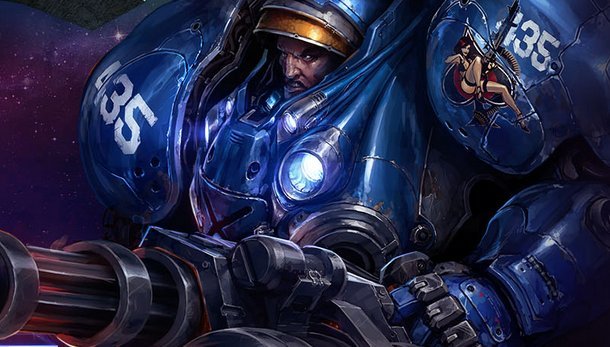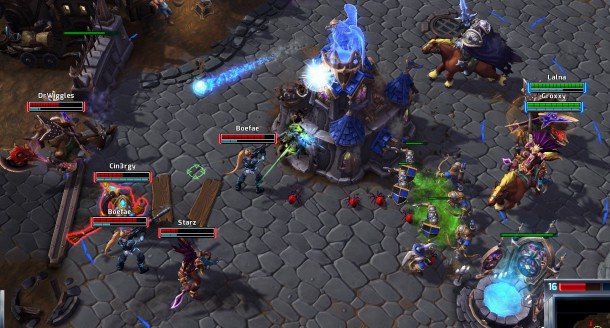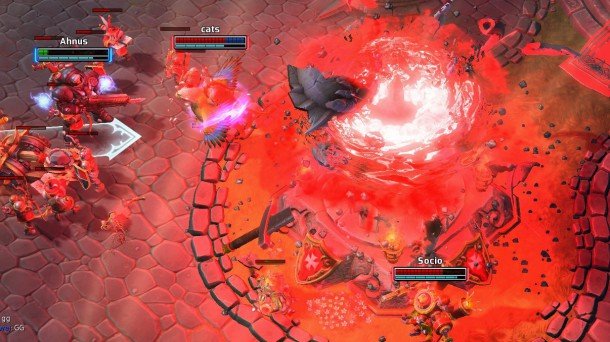Heroes of the Storm preview: entering the arena with Blizzard's all star cast of heroes

Heroes of the Storm will divide people. Blizzard have taken strides to rework the Defence of the Ancients template for a broader audience, but even that benign effort is politically loaded in a genre this conservative, this hardcore, this embedded in the hearts and minds of so many people. Heroes is still a game where two teams of five heroes, each with distinct abilities, battle to destroy each others' bases by escorting waves of NPC minions along a set of lanes. Beyond that familiar formula, however, little has been left untouched.
Individual players no longer gather experience points or gold for themselves. Instead, teams level up as a unit and while your side might risk falling behind, you never will relative to your peers. Each map has a game-changing optional objective that teams must factor into their strategies. This might be a shrine that can be captured to turn one player into a super-powerful Dragon Knight, or an underground area where players can kill skeletons to boost the power of their Grave Golem, a special minion capable of punching through base defences. Matches are short and the game encourages teams to fight as a group from the very beginning. Strategy and timing are more important than hair-trigger skill, and reacting to the enemy team supplants the extensive extracurricular book-learning required to become adept at Dota 2.
The result is a game that serves newcomers well, particularly those players who've never felt comfortable committing the amount of time these games traditionally demand. Veterans of Dota 2 and League of Legends may feel restricted, however, by a tactical toolbox that feels truncated relative to what they are used to.
“It's challenging to change any rules in this genre,” says design lead Dustin Browder. “I've been surprised at the amount of rage that even the smaller changes have produced internally, and in the community.” This problem, Browder argues, is cultural rather than technical – and attitudes can be changed.
“We've found that with a bit of playtesting and courage that you can change quite a bit – the genre's actually pretty wide open. This genre is not one map, or one set of heroes.”

He compares the lane-pushing game to the earliest first-person shooters. “Some shooters have a sniper rifle and some don't – that's cool. I can imagine all of the different types of games in this genre that could be made. There's always a kernel of goodness in even our more radical ideas.”
Browder is an entertaining person to talk to. A veteran of the StarCraft II design team, he also worked on Red Alert 2 and the Battle for Middle- Earth series. He knows his RTS games, and he sounds infectiously excited about getting to deploy that expertise in a new context.
The biggest gaming news, reviews and hardware deals
Keep up to date with the most important stories and the best deals, as picked by the PC Gamer team.
In particular, Heroes of the Storm's attitude to game balance is markedly different to that of StarCraft II. “The balance of all of the games in this genre simply isn't as tight as a game like StarCraft,” Browder says. “StarCraft we designed to be balanced from the beginning. We made a lot of decisions about cool things we weren't going to do because we wanted the balance to be perfect. We're not going to have more than 14 units per side. That's it. We'll only have three races. That's it. Why? Balance! Balance!”
That matches are fair is still of paramount importance to Blizzard, a fact that Browder is keen to stress. They have three developers working full-time on mechanical balance. But Heroes of the Storm has given its designers the freedom to place innovation ahead of strict parity in a way they haven't been able to before.
This is an exciting thought for players as well as designers. The RTS is absolutely critical to Blizzard's history as a game development studio, and whatever else the company does they will always be the developers who created Brood War and Warcraft III. Even though its character roster is a tribute to Blizzard's past, Heroes of the Storm feels like the most substantially new design to come out of the studio in a long time. As accomplished as Hearthstone is, Heroes' roots stretch far deeper into the company's creative history. The lane-pushing game might have started as an offshoot of a Blizzard RTS, but it has become an opportunity for the developers to explore their past from a new perspective.

I've been playing the game since March, in a technical alpha that includes four maps and just over 20 heroes. They're a varied group. I began by trying to specialise in Diablo's archangel Tyrael – I assumed, somewhat unrealistically, that the head start afforded to alpha players might give me a skill advantage when the game is finally realised. What I've found instead is that Heroes of the Storm rewards being a generalist. Tyrael is a melee tank with a decent amount of manoeuvrability, but that's not a toolset you need in every situation. He's useful on Blackheart Bay, for example, where chasing down enemies carrying bundles of pirate gold is a key strategic concern. Elsewhere, however, there are other characters I'd rather be.
Falstad is one. A dwarf mounted on a gryphon, he has no access to the speed-boosting mounts that most other characters can ride. Instead, he can periodically fly directly a large distance across the map. Selecting passive bonuses that decrease the cooldown of his travel power makes you phenomenally mobile. I like to play him as a roaming capper, flinging myself behind enemy lines to snatch territory-revealing watchtowers or to clear mercenary camps, which temporarily recruit powerful NPCs to your side.
Support hero Uther makes for a good example of Heroes of the Storm's generous approach to hero roles. While his pair of healing abilities make him a natural back-rank utility character, it's possible to turn him into a dangerous tank with the right passive abilities. You can turn his most powerful heal into an equally dangerous damage spell, and upgrade his Divine Storm ultimate ability into a battle-turning mass disable.
My initial concerns about hero design focused on two heroes: Zeratul and Nova. Zeratul is a Protoss melee assassin with the ability to teleport, and Nova is a sniper who can create illusory decoys of herself. What they have in common is a passive ability that renders them invisible when they disengage from combat for more than a couple of seconds. Their presence on the map is a constant concern, and a rare break from Heroes' otherwise-forgiving design. This is a game where enemy aggression is signposted by the announcer, generous vision ranges, and small maps that make it difficult to lose people. Adding invisibility to the mix felt, at first, like a vast transmission of power to these very specific—and very popular—heroes.
Joining in 2011, Chris made his start with PC Gamer turning beautiful trees into magazines, first as a writer and later as deputy editor. Once PCG's reluctant MMO champion , his discovery of Dota 2 in 2012 led him to much darker, stranger places. In 2015, Chris became the editor of PC Gamer Pro, overseeing our online coverage of competitive gaming and esports. He left in 2017, and can be now found making games and recording the Crate & Crowbar podcast.


